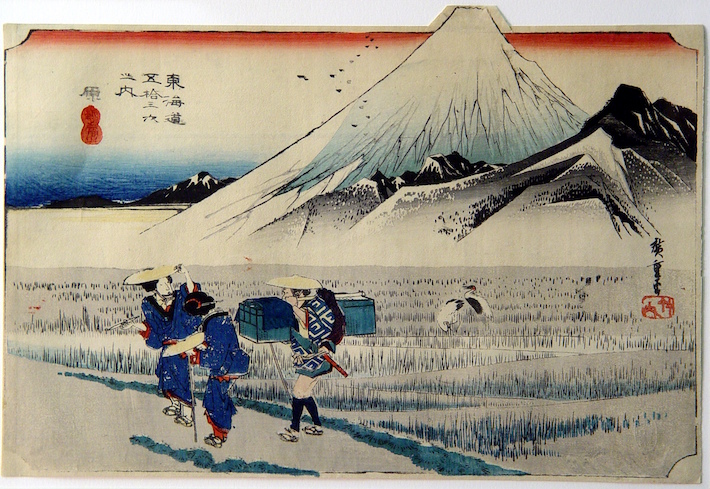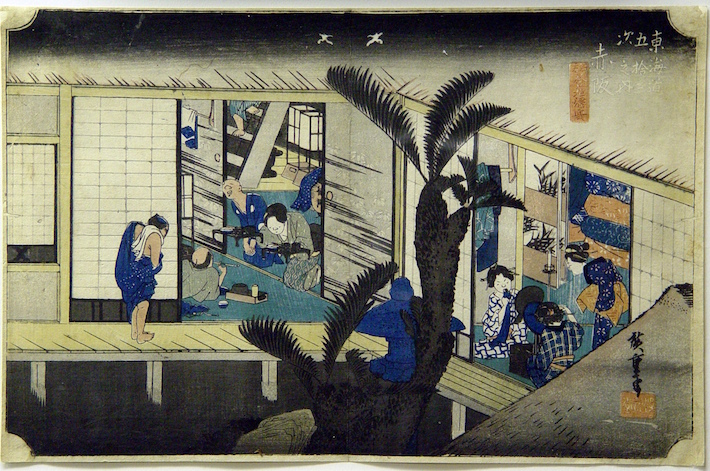During Japan’s Edo period from 1603 to 1868, the artist Utagawa Hiroshige gained a reputation as a leading landscape artist. One of his most seminal works was "Fifty-Three Stations of the Tokaido Road,” a series of woodblock prints published between 1833-34 that documented the artist’s pilgrimage along the Eastern Road, a route linking Edo (now Tokyo) with Kyoto, the ancient imperial capital of Japan.
Hiroshige’s entire series is at the George Washington University’s Luther W. Brady Art Gallery in an exhibition called “Along the Eastern Road: Hiroshige's Fifty-Three Stations of the Tokaido,”organized by the Reading Public Museum, Reading, Penn.
The Eastern Road spanned 310 miles and was used by merchants, nobleman and tourists who would stay in small inns dotting the route. Hiroshige did the complete two-week trip, stopping at each of the road’s 53 stations and documenting what he saw using the tradition of "ukiyo-e,” or "floating world,” woodblock printmaking.
“Van Gogh copied his works, other Impressionists emulated the way he cropped his images and created condensed landscape panoramas. To have the full, first-edition set of the ‘Fifty-Three Stations of the Tokaido Road’ is rare and a treat for those who study and collect Japanese prints,” Director and Chief Curator Lenore Miller said.
The exhibition will serve as a companion to the museum's exhibition of Okinawan textiles opening this November. George Washington Today took a closer look at Hiroshige’s work and asked the Brady Art Gallery to pick some of the most iconic prints that illustrate the historic journey.

13th Station: Hara
The neighborhood of Hara, known for expansive views of Mount Fuji, was one of the early stops along the Eastern Road. In this wood block print, we see two female travelers and a servant, making their way past snowy rice fields with vistas of the mountains. Servants often accompanied women since highways were considered very dangerous during the Edo period.

29th Station: Hamamatsu
Here, Hiroshige offers a rural scene with a group of peasants warming themselves by a bonfire outside of the town of Hamamatsu. A view of the Hamamatsu Castle can be seen in the distance. Hamamatsu was the largest port station in the Totomi and Suruga provinces, with more than 94 inns for travelers to use. The town was located on the right bank of the Tenryu River, but as the river’s course changed, the station has moved approximately four miles from the river’s edge.

33rd Station: Futagawa
Futagawa was located almost 176 miles from the beginning of the Tokaido Road at Edo’s Nihonbashi Bridge. The stretch was three quarters of a mile long, and travelers would have refreshments at a local teahouse set in an otherwise bleak landscape.

35th Station: Goyu
In this print, Hiroshige plays with the idea of the meshimori onna, female food and shop sellers known for their persistence in attracting customers. The meshimori onna were common at the Goyu station, which was lined with inns and restaurants. Hiroshige has painted the women attempting to drag travelers into their businesses.
Goyu was a prosperous town established in 1601. However, after a central line of Japan Railways bypassed Goyu entirely, it lost some of its original grandeur. A train station was opened later, but its initial wealth never returned.

36th Station: Akasaka
Here, Hiroshige has painted a typical inn split by a sago palm in the center. To one side, travelers have their evening meals; to the other, geishas prepare for evening entertainment. These festivities made Akasaka one of the most popular post stations with many travelers.
To explore more of the Tokaido Road, visit the Brady Art Gallery’s current exhibition, up until Dec. 2. A Gallery tour by GW graduate student, Denisha Phipps, will be given in conjunction with Alumni Weekend on Friday, Oct. 28 at 4 pm. Ann Marie Moeller, Japanese textile scholar and independent curator, will discuss the fashions seen in the Tokaido Road prints on Wednesday, Nov. 30 at 5 pm at the university museum.


